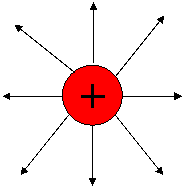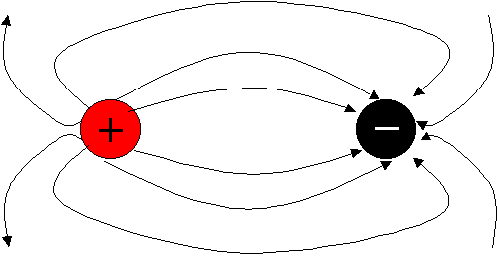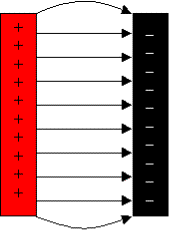Note-A-Rific: Electric Fields & Lines
Electric Fields
Just like
gravity, the force due to electric charges can act over great distances.
·
But most forces we deal with in everyday life are “contact forces”… objects
touch each other directly in order to exert a force on each other.
e.g. tennis racket hits a tennis ball
·
The
idea of a force acting at a distance without direct
contact was hard for early scientists, from Aristotle to
Then the British
scientist Michael
Faraday came up with the idea of a “field”.
·
A field is sometimes defined as a sphere of influence. An object within
the field will be affected by it.
·
Two
kinds of fields:
1.
Scalar Fields à magnitude but no specific direction
e.g. Heat field from a fire: If you stand by a campfire, you can measure
the magnitude (temperature) of the field with a thermometer.
2.
Vector Fields à magnitude and direction
e.g. Gravity field: Measure acceleration towards the centre of an
object.
·
We
deal almost all the time with vector fields in Physics 30.
An electric
field exists around any charge (positive or negative).
·
If one charge is placed near a second charge, the two fields will
“touch” and exert a force on each other.
·
N.B.
the field is NOT a force, but it does exert a force!
·
If
you are pushing a box, I don’t say you are a force, but you are exerting
a force.
How can we
detect and measure the electric fields around charges?
·
Easiest way is to place another known charge near by and see how it
reacts… but it has a field of its own, so that would affect your results.
·
Physicists
have defined a “test charge” as being an infinitely small, positive
charge.
·
It
is a mathematical creation… they don’t really exist.
·
Since
it is infinitely small, it has a minimal electrical field of its own.
·
Usually
given the symbol q’ (q prime)
·
Since
the test charge is positive:
·
if
we see the test charge move towards the other charge we know that one must be
negative
or
·
if the test charge moves away that one must be positive.
Remember, according to Coulomb’s Law, the force
exerted on the test charge must be directly proportional to its own charge and
the charge on the other object.
F a q1 q2 ß substitute the test charge in this relation
F a q’ q2
If you divide the force by the charge on the test
charge, you get a new formula.

E = electric field (N/C)
(Arrow above “E” in formula
shows this is a vector… it isn’t “energy” which is a scalar)
F = force (N)
q' = charge on test
charge (C)
Example: I place a 3.7 C test charge 2.7m to the right of another charge. If
there is an attractive force of 2.45N acting on the test charge, what is the
field strength at that spot?
We don’t need the distance to figure this question
out. It is important to know that the test charge is to the right of the other
charge, since we need to give a direction.
E = F / q’ = 2.45N /
3.7C = 0.66 N/C [left]
The field points left because that’s the direction the
test charge is being pulled.
Notice…
 is the force per unit charge
is the force per unit charge
 is the force
per unit mass
is the force
per unit mass
è
Gravity is a field also, a force acting at a distance ç
The direction of the field is always in the direction
of the force on a positive test charge.

The electric field around a charge will be different at
different locations around the charge.
1. Further away from the charge, the magnitude of the
force will decrease.

2. Direction will be different.
![]()
![]()

Example 1: A force of 2.1 N is exerted on a 9.2 x 10-4
C test charge when it is placed in an electric field. If the force is pushing
it West, what is the electric field at that point?

Example 2: If a positive test charge of 3.7 x 10-6 C
is put in the same place in the electric field as in the last example, what
force will be ![]() exerted on it?
exerted on it?
è F = E q = 2.3
x 103 N/C (3.7 x 10-6 C)
F = 8.4 x 10-3 N [West]
Since Coulomb’s Law is…

It can be substituted into the field formula to get…


Super Important Note:
·
It
is very important that you understand that in the example above the q’ is the
little test charge, and Q is the charge producing the electric field.
·
It
would be like doing an experiment to measure the gravity field on earth… m’
would be a little object you are dropping, and M is the mass of the earth,
which is producing the gravity field.
·
So,
in the formula above you will use the main, big charge that is actually
producing the field you want to measure.
·
This
is great! Now you don’t have to rely on some imaginary thing like a test charge
to calculate the field around a regular charge!
·
Also
notice that the formula ![]() is very similar
to the other gravity formula
is very similar
to the other gravity formula ![]() from Physics 20.
from Physics 20.
Using this formula, if you know the charge on an
object which is producing a field, and how far away you are from it, you can calculate
the field at that point.
Example: A tiny metal ball has a charge of –3.0 x 10-6 C. What is the
magnitude and direction of the field at a point, P, 30cm away?

·
Since
the electric field is always defined as being in the direction that a positive
test charge would move, this field points towards the metal ball. That’s
the direction you would state.
·
Get
used to names for a particular spot like “P”, since sometimes we may want to
relate what you’re doing in a question to several spots, like “P”, “D”, and
“A”.
Field Lines
An electric field is a vector.
·
Therefore,
we can represent an electric field with arrows drawn at various points around
an object with charge.
·
These
electric field lines (sometimes also
called lines of force) are drawn below for two simple examples.


·
Notice
that the lines are drawn to show the direction of the force, due to the
electric field, on a positive test charge.
·
Also,
the closer you get to the charge, the closer the lines are to each other.
o
This
is where the electric field is getting stronger, which makes sense since you
are closer to the charge.
o
If
you pick a spot further out, you’ll see that the lines aren’t as dense there…
so the field is weaker.
What would it look like if you had these two charges
close enough to each other that their field lines could interact?

·
The
arrows go from the positive charge
to the negative charge.
·
The
direction of the field at any point is the tangent drawn to the field line at
that point.
Another important example of field lines comes out of
the need to sometimes have a constant, uniform electric field.
·
As
you can see in the example up above, the field has very different field
strengths at different points… it’s irregular.
·
That’s
because it is made up of only two charges, so the field lines wrap around a
lot.
·
If
we could get a whole bunch of charges lined up evenly then we could get a more
uniform electric field.
·
It
is possible to set this up using two plates that are parallel to each other
with opposite charges built up on them.

The field lines are very uniform all the way, except
for a slight curvature at the ends.
·
We
often ignore this slight curvature, since it is very small as long as the
plates have a big surface area and are close together.
·
So,
we can say that we have a constant electric field between these parallel
plates.